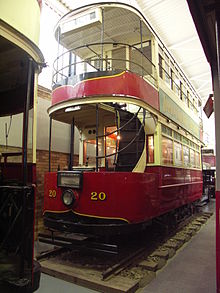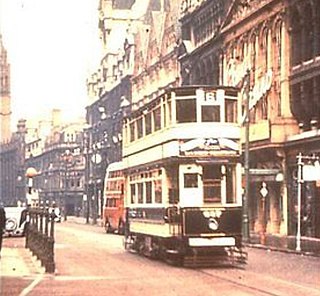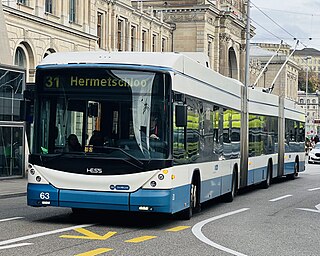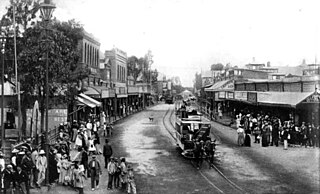| Johannesburg tramway network | |||||||||
|---|---|---|---|---|---|---|---|---|---|
 | |||||||||
| Operation | |||||||||
| Locale | Johannesburg, South Africa | ||||||||
| |||||||||
| |||||||||
The Johannesburg tramway network formed part of the public transport system in Johannesburg, South Africa, for just over 70 years until the start of the 1960s.
| Johannesburg tramway network | |||||||||
|---|---|---|---|---|---|---|---|---|---|
 | |||||||||
| Operation | |||||||||
| Locale | Johannesburg, South Africa | ||||||||
| |||||||||
| |||||||||
The Johannesburg tramway network formed part of the public transport system in Johannesburg, South Africa, for just over 70 years until the start of the 1960s.
Opened on 2 February 1891, the network was operated initially by horsecars. [1] From 14 February 1906, it was converted to electrical power. [2]
Beginning on 26 August 1936, the trams were gradually supplemented by the Johannesburg trolleybus system, which was opened on that day.
However, the tramway network lasted for several more decades, until its closure on 18 March 1961. The last scheduled trams ran on the Kensington, Bez Valley and Malvern routes on the day before, and on the day of closure special commemorative trips were run. The trams on those routes were replaced by buses.

Birmingham Corporation Tramways operated a network of tramways in Birmingham from 1904 until 1953. It was the largest narrow-gauge tramway network in the UK, and was built to a gauge of 3 ft 6 in. It was the fourth largest tramway network in the UK behind London, Glasgow and Manchester.

Trolleybuses in Wellington were part of the Wellington public transport system from 1924 until 1932 and again from 1949 until 2017. It was the last trolleybus system operating commercially in Oceania and the last major system operating in a country where driving is on the left side of the road.

Dundee Corporation Tramways formerly served the City of Dundee in Scotland. The corporation had financed the construction of a horse tramway in 1877, but had then leased it to the Dundee and District Tramways Company. They had replaced most of the horse trams with steam tram locomotives pulling trailer cars from 1884, but in 1897 the corporation decided that it would run the tramway system itself. After some negotiation and the payment of compensation, they took over the system in 1899, with a view to electrifying it. Electric trams started running in 1900, and the changeover was completed in 1902.

The Glasgow trolleybus system operated in and immediately surrounding the city of Glasgow, Scotland, between 1949 and 1967, with the network reaching its largest extent in 1959. It was the only British system to open after World War II.

The Adelaide trolleybus system formed part of the public transport network in Adelaide, South Australia from 1932 until 1963.

The Huddersfield trolleybus system once served the market town of Huddersfield, in West Yorkshire, England. Opened on 4 December 1933, it gradually replaced the Huddersfield tramway network, which closed on Saturday, 29 June 1940.

The Grimsby trolleybus system once served the seaport of Grimsby, in Lincolnshire, England. Opened on 3 October 1926, it gradually replaced part of the Great Grimsby Street Tramways, a tramway that had served both Grimsby and the neighbouring holiday resort of Cleethorpes. It was closed on 4 June 1960.

Cardiff Corporation Tramways was a company that operated an electric tramway service in Cardiff between 1902 and 1950.

The Zürich trolleybus system is part of the public transport network of Zürich, Switzerland. Opened in 1939, it combines the Zürich S-Bahn, the Zürich tramway network and Zürich's urban motorbus network to form an integrated all-four style scheme.

The Brisbane trolleybus system was part of the public transport network in Brisbane, Australia from 1951 until 1969. The Brisbane City Council operated 36 Sunbeam trolleybuses on a 28 kilometre network.

The Sydney trolleybus system in New South Wales consisted of two unconnected lines in the Eastern Suburbs and St George areas of Sydney.

The Cape Town trolleybus system was part of the public transport network in Cape Town, South Africa, for nearly 30 years in the mid-twentieth century. The trolleybuses on the system were always referred to by English-speaking locals as "Trackless trams", and even the systems's stops were marked "Trackless Tram Stop".

The Durban trolleybus system was part of the public transport network in Durban, South Africa, for more than 30 years in the mid-20th century.
The Johannesburg trolleybus system was part of the public transport network in Johannesburg, South Africa, for nearly 50 years in the mid-twentieth century.

Cape Town, South Africa, has had two tramway networks forming part of its public transport arrangements. Both networks are now long closed.

The Durban tramway network formed part of the public transport system in Durban, South Africa, for nearly 70 years until the end of the 1940s.
Llanelly and District Electric Tramways operated a standard gauge tramway service in Llanelli, Wales, between 1908 and 1933. It was the successor to a 3 ft gauge horse tramway, which ran from 1882 until 1908. A complex series of negotiations took place in the early 1900s, resulting in the horse tramway being converted to an electric tramway. Standard gauge horse trams were run initially, until the company completed North Dock power station, which supplied electricity to the tramway. Two of the employees who worked on the construction went on to found Balfour Beatty.

The Kimberley tramway network formed part of the public transport system in Kimberley, Northern Cape, South Africa, for roughly 60 years until the late 1940s. Operation started with horse-drawn trams, on 21 June 1887. Mules replaced the horses in the early 1890s. For a few years starting in 1900 tram sets hauled by steam tram engines were also operated on some lines. The first day of public service for electric trams was 25 April 1905. The first electric trams were four single-deck cars purchased from the John Stephenson Car Company, of New York. More trams were purchased later from the J. G. Brill Company and the United Electric Car Company.

The Biel/Bienne tramway network was part of the public transport network of the bilingual city of Biel/Bienne, in the canton of Bern, Switzerland, and its environs for more than 70 years. Opened in 1877, the network operated as a horsecar tramway (Rösslitram) until 1902, when it was electrified and converted from 1,435 mmstandard gauge to 1,000 mmmetre gauge.
Bradford Corporation Tramways were a tramway network in the city of Bradford, West Riding of Yorkshire, England which operated trams from 1882 until 1950 and trolleybuses from 1911 until 1972. The track gauge of the tramways was 4 ft.
![]() Media related to Trams in Johannesburg at Wikimedia Commons
Media related to Trams in Johannesburg at Wikimedia Commons